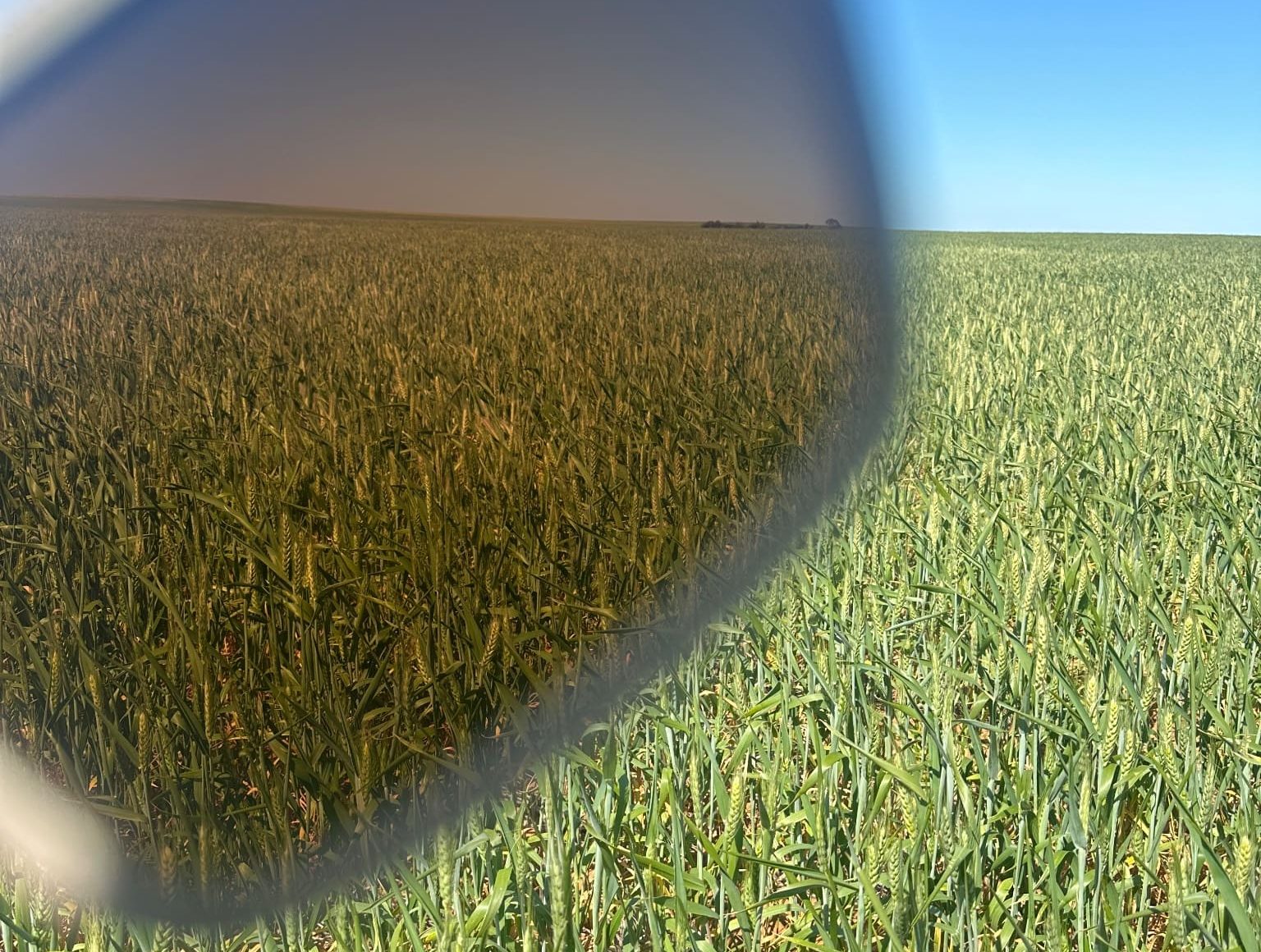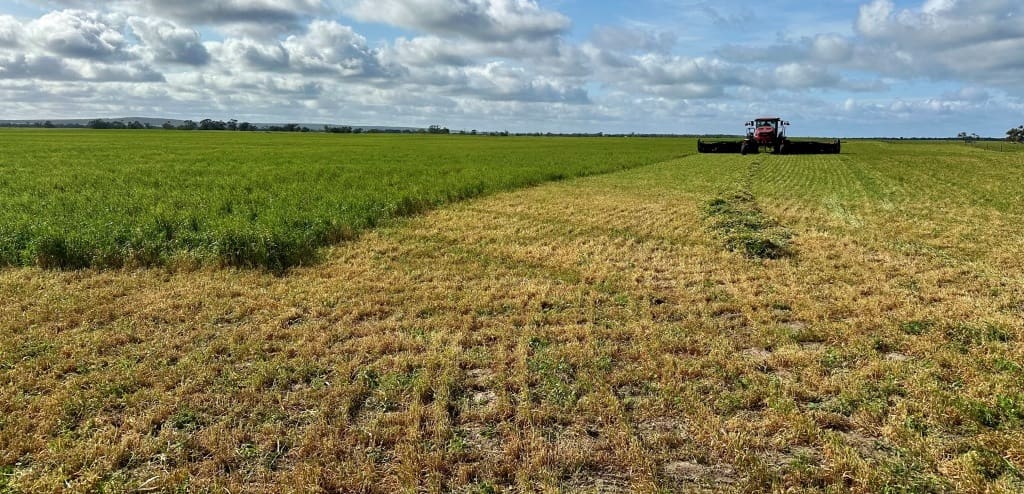
Frost has hit a number of cereal crops in SA and Vic, including this one at Loxton in SA’s Murray Mallee seen through a polaroid lens. Photo: Jock McNeil
HAYMAKING is off to an unusually early start in parts of South Australia and western Victoria, where some cereal and canola crops will not make it to harvest.
The decision to drop some crops for hay is being made following a tough start to spring, which instead of bringing the hoped-for rain and mild temperatures, has brought frost and precious little rain.
Sliding grain prices, prospects for below-average yields, and expectations that challenged crops will struggle to hit quality parameters have all fed into farmers’ decisions to cut a paddock or two for hay.
For some, the silver lining is buoyant lamb and sheep prices.
This is offering mixed farmers the chance to value-add through their own enterprises, or sell to graziers in Vic’s Western District and SA’s South East who are looking for feed after what for many has been the driest calendar year to date in living memory.
For pulses in the flowering and podding stage, frost has burnt off some yield potential, but this could be recouped if rain falls in the next week or two.
Following is a link to a video by Frontier Farming pulses research agronomist Dr Jason Brand showing some early signs of frost damage at a Vic trial site:
https://1drv.ms/v/s!Arf2rIQbMzVkrbRzx_iec3gmlXaxZw?e=HNkW8f
Victoria
Frost in the past week has been the catalyst for a number of growers to spray out their crops for hay, while a ryegrass infestation has been a consideration for others, including Birchip, Vic, grower Alistair Ferrier.
“If we had have had another rain in August, I probably wouldn’t be cutting it for hay,” Mr Ferrier said.
“I’ve just got a paddock I need to clean up, and I’m concerned about the season.”
A frost on Monday morning has galvanised Mr Ferrier’s decision.
“With the grain price being fairly soft, it makes economic sense to cut it for hay.”
The crop is being sprayed out this week, and will be baled by a contractor.
Contractors’ phones have started to run hot, as croppers in the Mallee and Wimmera who do not normally produce hay start to run the ruler over the cost of baling struggling crops, and how much they can expect to get for bales.
“In the Mallee, we source vetch and oaten hay, and now they’re talking about barley and wheat for hay, which is not normal,” Green & Gold Contractors director Matt Dohle said.
Evident in all districts is the impact of patchy and generally late germination in Vic crops, particularly on heavier country, and below-average in-crop rain.
Many Vic crops are doing well if they have jagged good rain and are into subsoil moisture, and could well achieve average yields.
Other crops have a 50/50 chance of being cut for hay in coming weeks, or making it to harvest.
“They’re still hanging in there, and they haven’t pulled the pin on them yet.”
“We’re getting calls from growers we have done hay for in the past, and from ones we haven’t, so they can crunch a few figures.”
In the latest Hay Matters podcast released September 12, Feed Central national sales manager Dave Clothier said a lot of hay in the northern half of New South Wales has already been cut, and yielded 5-6t/ha in its stellar season, in contrast to the situation in parts of SA and western Vic .
“Talking to some guys, where they were getting sort of 8t/ha, they’re going to be back to three and four; they’re pretty down in the dumps,” Mr Clothier said.
“That really safe southern producing area is not going to have a lot of supply, and that area largely will become buyers rather than sellers.
Mr Clothier said hay being made now in south-west NSW could move north and south, instead of following the normal pattern and heading north only, and some Vic and SA hay exporters would be looking for volume from outside their normal supply areas.
“Because South Australia’s yields are well back, they will travel further north to secure volume.
“The reality is the stockpile’s gone.
“It’s a good time to buy right now…but I don’t think the prices will truly stabilise until we understand what that national stockpile looks like, which will be towards the end of October and the start of November.”
Frosted crops generally have a yield expectation of 2-3t/ha, with the rule of thumb being that 1t/ha goes to paying the contractor.
This is increasingly being seen as a better return than harvesting crop likely to yield around 2-2.5t/ha, particularly if screenings are too high and testweights too low for grain to make anything but off-spec segregations.
South Australia
In SA, talk is filtering through of some canola crops in the Upper North being cut for hay, and a reasonable number of wheat crops are about to be dropped after frost events in the past fortnight.
“There’d be a lot of crops that will get cut for hay that were planted for grain; certainly wheat will be coming down,” Platinum Ag agronomist Phil Holmes said.
“There’s certainly wheat crops everywhere being cut; it’s less risky than waiting for the next rain.
“We might get the rain, but we’ve been thinking that all year; people are risk-averse at the moment.
“With the price of hay relative to grain, hay is better.”

Frost has affected wheat crops like this one at Bute on SA’s northern Yorke Peninsula, and cereal and pulse crops in patches across all parts of YP. However, widespread cutting of crops for hay is not expected at this stage. Photo: James Venning, Barunga Grains
Mr Holmes is based at Clare in the Mid North and covers an area that stretches south to Roseworthy and north to Jamestown.
“It’s pretty dismal wherever you go.”
Mr Holmes said most soils are devoid of stored moisture, but paddocks that grew vetch or other less thirsty crops last year are looking better than ones that took more out of the soil for cereals or canola.
Some lentil crops appear to have lost significant yield potential in the past fortnight.
“Lentils do not like frost, and the more advanced ones will be most affected; towards Balaklava and Roseworthy, they’ll be more advanced in pod fill, and those pods will be smacked by the frost.”
Mr Holmes said barley heads are still in the boot, which makes them less exposed but not immune to frost damage.
“The crops have stopped like statues – wheat, barley and oats are not pushing their heads out; they need a rain to get the energy to push the heads out of the boot.
“If they got a bit of rain now, they could go quickly, but they’re stuck in limbo.”
The Lower and Mid North are big producers of oaten hay for export, and Mr Holmes said short straw means what is soon to be cut could well have a larger-than-normal proportion of last year’s stubble in the bale, which would lower overall protein.
“Exporters are worried about residue; they don’t want that.”
Clare is one of SA’s premier cropping districts, and average wheat yields are around 4-4.5t/ha.
“I’d say 2-2.5t/ha is the upper limit now for our crops.”
After a calendar year to date of decile 0-2 rainfall, Mr Holmes said rain now would enable cereal crops to fill seed and avoid the risk of pinched grain.
“Without a drop of rain, what we’re producing would be screenings – light, fluffy seed.
“Rain would fill the grain we have and give us sowing seed for next year.”
At Field, between Coonalpyn and Meningie in SA’s Upper South East, Schulz Livestock principal Jason Schulz is running around 2400 Merino ewes and 70 breeder cattle.
He said the brutality of the driest season on record means livestock producers are having to make “some pretty fast-acting decisions”.

Lucerne oversown with barley being cut for silage last week on Schulz Livestock’s farm in SA’s Upper South East. Photo: Jason Schulz
The operation rotationally grazes, and sows fodder crops which in typical years are shut up for hay and silage, with perennial lucerne-based pastures used to get ewes through winter.
“In our typical season, we feed silage to lambing ewes and hay to our cattle,” Mr Schulz said.
“I don’t grain-feed ever, and we’ve bought four B-doubles of pellets to get through winter just for the sheep.”
Schulz Livestock started light supplementary feeding stock in March, and took delivery of the first load of pellets in early May.
“When we were lambing in June on nothing, we reached out to friends in the Mallee and said: ‘How do you do this?’
“With no seasonal opening rain, we had no activity from the lucerne.
“It’s only in the last four weeks we’ve had growth from lucerne accessing the water table.”
His pastures have had a major setback from a frost which bottomed out at -4.6 degrees Celsius on Monday morning.
“We had a very severe black frost; any pasture that was ahead of the stock has been badly frosted.
“Paddocks look like they’ve been spray-topped.”
Mr Schulz said their operation aims to have two years’ supply of fodder at all times, and is cutting silage now to help replenish what has been eaten this year.
He said graziers in the Lower South East generally only have enough fodder on hand to last one year, and are therefore looking to both fill their sheds, and keep the nutrition up to their stock.
Mr Schulz said the property last had a soaking rain in December, and has been surviving on single-digit or sub-20mm falls since.
“It’s enough to keep us optimistic.”
Grain Central: Get our free news straight to your inbox – Click here

HAVE YOUR SAY